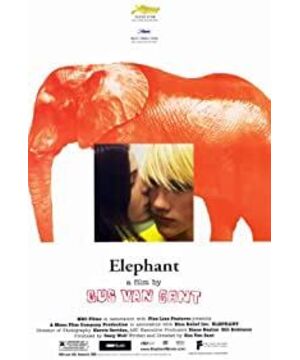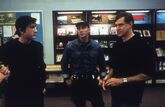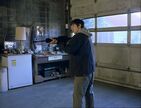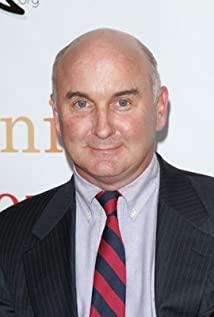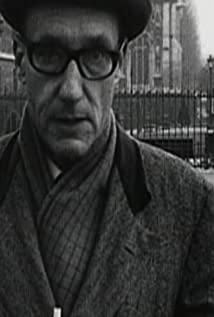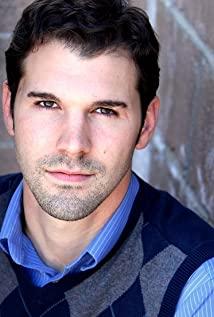The title of the movie is "The Elephant". Surprisingly, except for the hand-painted elephant on the wall of the actor's bedroom, there is almost no shadow of an elephant in the whole movie, not even like the "Lamb" in "The Silence of the Lambs". been mentioned several times. People have three guesses about the title of the film: The first is because adolescent elephants are the most irritable and most dangerous, such as the discriminated boys Alex and Eric in the film.
The second, explained by the BBC’s 1989 film of the same name about political violence in Northern Ireland, The Elephant, both posed the same problem – being ignored: like an elephant in a living room, people either Pretend it can't be there, or think it's not a real elephant, from the saying "elephant in the room";
a third, from a fable in an Indian Buddhist scripture, a man trying to It is impossible for a blind person who can identify an elephant to accurately describe the complete image of an elephant. Each blind person depicts different existences according to the parts he touches, which is exactly the same as the story of "the blind man touching the elephant" in ancient China. For the same thing, everyone thinks that he is one-sided to be the correct answer, but in fact everyone only sees a part or an aspect of the thing - each one's own part, one aspect of his own position. As Van Sant said: "We don't make any special explanations for such horrific events. We just want to express it freely and leave some space for the audience to think." The students' different perspectives reflect the situation before and during the shooting, trying to present the entire process of the shooting with a calm attitude and stylized narrative.
Director Van Sant has always favored teen themes, such as the illegal immigrants in "Night of Evil" ("Mala Noche" 1985), the male prostitute in "My Own Private Idaho" (1991), The confused teenagers in "Paranoid Park" ("Paranoid Park" 2007) are very similar, and even blend with each other - rebellious and rebellious, unrestrained, uninhibited, confused, and easily angered and difficult to socialize , is marginalized. Therefore, it is logical that the gay high school students who were discriminated and bullied in the school in "Elephant" became the protagonist of the film under the lens of Van Sant. And during that time, from 1997 to 1999, there were about eight school shootings in the United States, and Van Sant, who likes to photograph sensitive subjects, chose the most thrilling one, not only Expressing his irresponsible and irrational scrutiny of teenagers, it also increases the selling point of the film and raises its attention, which is a wise way of operating an independent film. The director himself does not explain, the audience is not a fool, the naturalistic documentary images that seem to understate the bystanders are more for people to reflect on - not to blame homosexuality, not to blame Nazism, not violent games, but teenagers The atmosphere of growth, the environment of the school and the general environment of the whole society. A foreign teacher of the history of civilization I once said (although a bit pessimistic): "The Western world is now a world without culture, many young people have become 'two-legged animals' (biped), and only eat every day , sleeping, fighting and mating..." Gus interviewed many students for the filming, and finally he said, "Some middle school students think their life is a mess, some are very satisfied, but some people directly say that campus life is hell" ( Quoted from the French poster of The Elephant). The young people in the film are not without emotion, they have tears and fear, but some people have not learned tolerance, understanding and love. One of the teens said they did it out of love, but the killing wasn't love.
School shootings are hard not to think of American gun culture. American sociologist Herman Conn once said: "Guns are the core of American culture." According to the statistics of the "Tobacco, Alcohol and Firearms Administration" in 1998: including rifles, pistols and shotguns, there are about 230 million in the United States. Firearms are scattered among the people. The reason why American law does not ban guns is because "the American people are free to overthrow tyranny" (from the Declaration of Independence). In the eyes of Americans, the gun is not just a tool, but an extension of power. In the history of the American Revolutionary War, the decisive role played by the militia added a sacred meaning to the holding of guns - the militia fired the first shot in Lexington, kicking off the Revolutionary War. In the eyes of many Americans, America was able to gain independence in large part because everyone had a gun. There are also many gun-related words in English that are often slightly praised and praised, such as: big gun - an important person of influence; go great guns - dry with high speed and efficiency; with guns blazing - very hard , warmly. Not only that, but probably the most famous hard rock band in the world, Guns N' Roses, or Guns N' Roses for short. It is not surprising that guns, which are regarded as dangerous goods in other countries, are regarded as "symbols of order and totems of conservatism" in the United States. While gun culture isn't the primary cause of the shootings, a general awareness of gun worship is part of the story's larger context.
The regularity of the structure is the rule for the survival of Hollywood films. Breaking the conventionality of the narrative structure is the magic weapon for independent filmmakers to go to Cannes. "The Elephant" does not adopt any existing narrative template, but puts the combination of time and events in the first place, so we see the same scene appearing many times behind several people, a person who has already walked in our consciousness Time appears in front of us again, and repetition has both an emphasis and a more comprehensive feature. When we look at the same problem from several perspectives, we will find that one problem has become several problems. The repetition in "The Elephant" In addition to the detailed explanation, it also enriches the originally weak characters' feelings and characterizations. Different people walk different paths and form relationships with different people, which has a special meaning.
Naturally, the director did not think too much about the time when the climax of the movie came, or the director did not pay attention to whether the movie needs a climax at all. For some movies, the succession and excellence of the climax is a weapon for them to earn the box office. Saying calm soothing output of thoughts and opinions is the only thing that matters. As far as "The Elephant" is concerned, the shooting part is strongly distorted from the previous part. The calm and over-saturated colorful pictures become surly and bloody with the sound of the gunshots, whether it is psychological or physiological to our defenseless. Visuals are a huge hit. But the director is not trying to drag us out of a slow and even dull rhythm, but we find that the movie is so capable of restoring time that we can imagine how a cookie-cutter morning on campus can suddenly change. It was a bloody storm, and during this period, there was no need for any foreshadowing and hints, just a dash. And this direct contrast between softness and violence can be regarded as a unique violence aesthetics.
What left a deep impression on the audience was the end of the film. The camera did not explain the life and death of the lovers. This open ending with uncertainty and ambiguity made the film once again show the characteristics of postmodernism, which Speculation, debate and reflection are left to the audience.
Many characters do not appear in most of the time in the film, especially the life fragments that are almost unrelated to each other, trivial and messy. However, the director chose to use different perspectives to show the different states of different people before and when the same event happened. With a soothing rhythm, beautiful pictures, exquisite shots, and deep metaphors, it showed the alienation of human nature and the lack of collective sense. , self-closure, repression and irrational violent tendencies. It is indeed a rare good movie, no wonder the Palme d'Or and the Best Director Award are favored.
The proliferation of school violence is a wide-ranging social problem. The film restores it to us through its narrative. We are surprised at its cruelty and blood when we see it, but this is not the power and value of the film, the power and the power of the film. The value lies in allowing us to have some insight and reflection after seeing these terrifying scenes. When we look back at what we have done, we have an overwhelming sense of shame. Have we inadvertently created hurt people? the atmosphere of seeing the wounded; how much time does the heart of compassion go unnoticed?
We believe that film, as a means of artistic expression, with its ability to spread widely, can do more things and inspire us more, just like the calm narrative "The Elephant" can generate waves in people's hearts , other expressions of compassion, or understanding of various groups can create a value.
That's the value of cinema and its power.
View more about Elephant reviews


